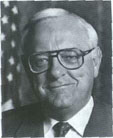|

|
STRANDED MOTORISTS URGED TO
'STAY PUT. STAY SAFE'
By SECRETARY OF STATE GEORGE H. RYAN
|
A new public service campaign designed to help
motorists who become stranded on Illinois highways
was introduced at the 1995 Chicago Auto Show in February. The program, called "Stay Put. Stay Safe.," educates drivers about the importance of staying inside a
disabled vehicle and calling or signaling tor help without leaving the vehicle.
Driver safety is a top priority of my office. This
program helps give motorists peace of mind when driving and, in the event of a roadside emergency, ensures
their safety until a police officer arrives.
Thirty thousand "Stay Put. Stay Safe." motorist assistance kits were distributed at the Auto Show. The kits
contain a visor card with step-by-step instructions for
obtaining help without leaving the vehicle, as well as
cellular emergency numbers. The kits also include an
emergency sign with the words "I've Called The Police" on one side and "Call The Police" on the other side
to display in the back window of a stranded vehicle.
In addition, driver's license facilities throughout the
state are displaying posters and offering flyers containing information about the program.
According to the American Automobile Association, 1993 emergency road service calls were the highest
ever with 24.6 million calls recorded in the U.S. and
Canada. That is 10 percent more than in 1992, and the
biggest percentage increase in 17 years. Two-thirds of
the calls were for problems other than a car that would
not start.
Contributing to these statistics, more Americans are
driving older cars on our highways, resulting in more
frequent breakdowns. Today, the average car is 8.1
years old, the highest average since 1948.
The "Stay Put. Stay Safe." program is co-sponsored
by Ameritech, which is providing emergency kits, posters and public service announcements. The following
advice for motorists involved in a highway emergency
was developed in conjunction with the Illinois State
Police Safety Education Department:
1. Get off the road. Use your flashers and headlights
to alert other drivers and to signal for help.
2. Communicate your problem to other drivers.
Exit the car on the non-traffic side and lift the hood or
stay in the car and put a piece of white fabric out your
window as a distress signal. Use a cellular phone to call
emergency personnel and place the "I've Called The
Police" sign in your rear window. Display the "Call The
Police" sign if you need assistance.
3. Stay in your car. Never walk for help. Remain in
your car with the doors locked and windows up until
help arrives. If you leave the scene of the breakdown,
you risk car theft or personal injury.
4. Be selective about your help. Don't unlock the
doors or accept help from anyone but a uniformed
police officer. Crack the window and ask others to
notify the police or call a tow truck.
5. Be prepared! Equip your car with a cellular
phone. In cold weather, carry warm clothing, blankets,
flares and sand.
People are using cellular phones for more than just
business. About half of current buyers purchase a cellular phone to enhance their personal safety or for some
other personal reason, according to the Cellular Telecommunications Industry Association.
Because cellular phones allow people to communicate whenever and wherever they want to, cellular
phones are becoming an important part of crime prevention and public safety. In 1993, more than 500,000
calls per month nationwide were made to emergency
assistance numbers from cellular phones.
I am pleased that my office was able to form an
alliance with Ameritech to enhance the safety of Illinois
motorists during a highway emergency. Ameritech is
distributing 200,000 motorist assistance kits this spring
while supplies last. Kits also are available at Ameritech
cellular stores and by writing to Cellular Services,
Ameritech Center Building, 2000 W. Ameritech Center
Drive, Hoffman Estates, IL 60195-5000. •
April 1995 / Illinois Municipal Review / Page 21
|